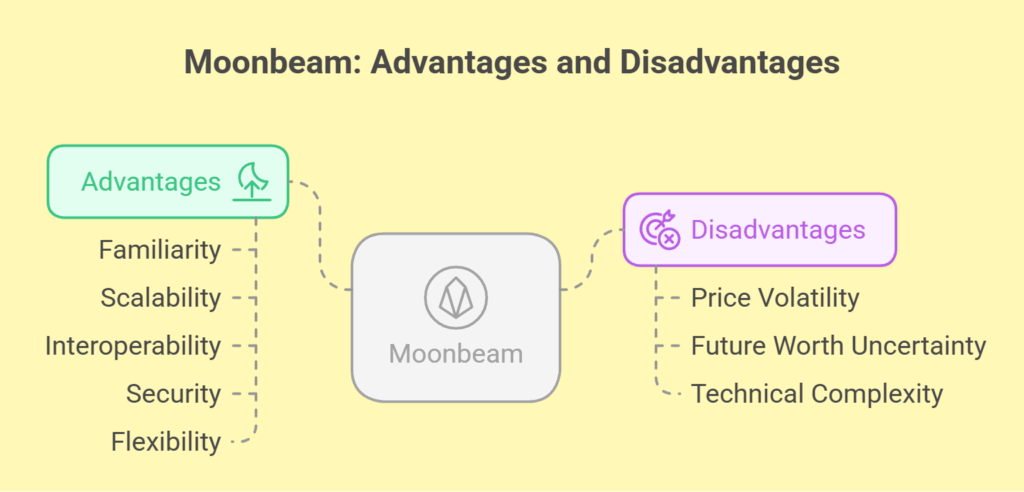Blockchain moonbeam

Moonbeam is a Polkadot parachain for smart contracts. Its main purpose is to connect the enormous Ethereum development community to Polkadot’s scalable and interoperable environment. Moonbeam launched on Polkadot on January 11, 2022.
Who Uses Moonbeam
Moonbeam appeals to both new projects requiring interoperability and smart contracts, as well as those already working on Ethereum who want less prices and quicker transactions. It streamlines the Web3 experience and makes it dependable, quick, and simple.
Founder
Derek Yoo, the CEO of PureStake and the founder of Moonbeam. He was a co-founder of the Fuze communication platform and has extensive experience in the IT industry. His goal for Moonbeam was to address blockchain ecosystem interoperability issues.
Core Problem Moonbeam Solves
Moonbeam addresses blockchain fragmentation by separating Layer 1 blockchains like Ethereum, Solana, and Avalanche by functionality, developer tools, and users. This disarray poses difficulties for:
- Developers must rewrite code, learn new languages (like Rust for Substrate), and use new toolkits to move dApps between chains.
- Users: Separating assets and capabilities on chains limits dApps’ reach and usefulness.
Moonbeam tackles these issues by providing an Ethereum-like environment in Polkadot. It aims to make Web3 more cross-compatible and interoperable.
Key Features and How It Works
Moonbeam’s Ethereum compatibility is unique
- Developers may simply port Ethereum’s Solidity smart contracts to Moonbeam.
- Moonbeam emulates Ethereum’s Web3 RPC, letting developers use Hardhat, MetaMask, Waffle, Remix, and Truffle. For Ethereum developers, this drastically cuts down on the learning curve and development time.
- Unified Accounts and Signatures: Moonbeam offers a smooth user experience by allowing users to communicate with it using their current Ethereum H160 accounts and ECDSA signatures. Moonbeam accepts validated addresses, wallets, and smart contract signatures from various Solidity networks.
- It supports ERC-721 (for NFTs) and ERC-20.
- Moonbeam supports Solidity, Vyper, Flint, and JavaScript, all EVM bytecode languages.
Functions as a Parachain of Polkadot’s
Moonbeam is a Polkadot parachain, not a blockchain.
- It doesn’t need to bootstrap its validator set because it shares Polkadot Relay Chain’s strong security.
- Polkadot’s XCM protocol helps Moonbeam, a Parachain, effortlessly share data and assets with other Parachains. This enables complex multi-chain applications. Additionally, it links to Polkadot Relay Chain.
- Scalability: Moonbeam adds to the Polkadot network’s overall scalability by shifting execution to a dedicated Parachain.
- Linking to Polkadot: In January 2022, Moonbeam won a “coretime” (parachain slot) auction on Polkadot, where users pledged about USD 1 billion in DOT tokens. This allowed Moonbeam to secure its parachain position on Polkadot.
Substrate Framework
Moonbeam is based on Polkadot’s modular blockchain development platform, Substrate, and is compatible with EVM. This offers adaptability and makes sophisticated features possible:
- Polkadot’s advanced on-chain governance is advantageous to Moonbeam since it permits token holders to take part in network enhancements and parameter modifications without requiring hard forks.
- Staking: To assist collators and receive incentives, users can stake their GLMR (Moonbeam’s native coin).
- Customisation: Future integration and customisation of particular modules (sometimes known as “pallets”) that expand Moonbeam’s capabilities beyond those of the standard EVM features are made possible by the Substrate foundation.
Cross-Chain Integrations (Bridges)
Moonbeam serves as a hub for a truly connected Web3 by actively integrating with a number of bridges, including cBridge, Multichain (also known as Multichain Swap Protocol), and RelayChain, to enable asset and data transfers both inside Polkadot and with external networks like Ethereum and Bitcoin.
Kusama Canary Network’s Moonriver
Moonriver (MOVR), a sister network of Moonbeam, functions as a Parachain on Kusama, Polkadot’s “canary network”. Before being deployed on Moonbeam, new features and dApps can be tested in a real-world economic environment using Moonriver, which improves Moonbeam’s security and stability.
Native Token: GLMR (Glimmer)
The Moonbeam network’s native utility and governance token is called GLMR.
Functions
- Paying Transaction Fees: Used to cover petrol costs associated with Moonbeam’s smart contract and network transaction execution.
- Network Security (Collator Staking): Collators that generate blocks stake GLMR, guaranteeing network integrity. In order to assist Collators and receive incentives, nominees can also stake GLMR.
- On-chain Governance: As part of Moonbeam’s on-chain governance, GLMR holders have the ability to propose and vote on referenda for treasury allocations, network development, and parameter modifications.
- Auctions for Parachain Slots/Coretime: To assist ensure Moonbeam’s continuous parachain slot on Polkadot, a portion of GLMR inflation is set aside for a “parachain bond reserve”.
Tokenomic Information
- The initial supply of GLMR tokens is one billion.
- The parachain bond reserve and treasury receive a share of the 5% yearly inflation rate, which is mostly used to reward collators and nominators through staking payouts.
- Fee Burning: On Moonbeam, a sizable amount (80%) of transaction and smart contract execution fees are burned, which puts pressure on inflation. The network’s treasury receives the remaining 20%.
Applications
Moonbeam is a flexible platform for a range of decentralised apps that need Ethereum compatibility and cross-chain capability. Among the use cases are:
- DeFi Hubs: introducing stablecoins, lending protocols like Moonwell, yield farming platforms that can communicate with assets from many chains, and decentralized exchanges (DEXs) like StellaSwap and BEAMSWAP.
- Gaming: Developing the upcoming Web3 game generation with seamless cross-chain tools, reduced fees, and improved user ownership of in-game assets (NFTs). EVRLoot is one example. The website regularly advertises its games, tournaments, and gaming hub.
- Tokenisation of Real-World Assets (RWAs): Enabling the integration of real-world assets (such as commodities, real estate, and invoicing) into DeFi through tokenisation. As an illustration, Carbify uses Moonbeam to offset carbon emissions using NFTrees.
- Applications that use decentraliszed networks for physical infrastructure, like Diode, an open zero trust DePIN network with messaging and VPN apps, are supported by decentralized physical infrastructure networks (DePIN).
- NFT Marketplaces and Collectibles: provide a platform like Treasureland and NFTrade for the creation and trading of NFTs with cross-chain functionality.
- Identity management is the creation of universally accessible, decentralized identity solutions for various blockchain environments.
- The safe and dependable transfer of off-chain data onto Moonbeam and other related chains is made possible via data oracles and analytics.
According to March 2025 data, Moonbeam has 257 projects overall and more than 200 apps that are now live.
Advantages and Disadvantages of Moonbeam

Advantages of Moonbeam
- Familiarity: The migration process is simple because developers may utilize the same Ethereum tools and code.
- Scalability: Gains from Polkadot’s parallelism and performance, which allows for faster finality and far lower transaction costs than Ethereum. The average transaction fee is $0.019 and the average block time is 5 seconds.
- Interoperability: Able to communicate with other blockchains and parachains through bridges and XCM.
- Security: Takes over the shared security of Polkadot.
- Flexible: Built with the Substrate architecture for on-chain governance and personalization.
Disadvantages of Moonbeam
- Price Volatility: Investors may be at risk due to GLMR’s price volatility, a common characteristic among cryptocurrencies.
- Future worth Development Uncertain: Investment risks are associated with the uncertainty surrounding GLMR’s future worth.
- Technical Complexity: Moonbeam’s technology is complicated, and improving compatibility requires constant development, which can be difficult.
| Property | Moonbeam |
|---|
| Network type | Parachain on Polkadot |
| Smart contract support | Yes (EVM & WebAssembly planned) |
| Language | Solidity, Vyper (Ethereum languages) |
| Native token | GLMR |
| Compatibility | Ethereum-compatible |
| Use cases | DeFi, NFTs, DAOs, cross-chain dApps |
